Step-by-step instructions: how to properly cover grapes for the winter
Grapes are a thermophilic culture. Sudden cold snaps lead to the death of the bushes and the defeat of young growth. In any climate, including areas of risky farming, unexpected frosts will not be terrible for the vine if it is prepared for wintering. How to cover grapes for the winter and what subzero temperatures this culture can withstand, we will tell in the article.
The content of the article
When grapes are covered
The grapes are covered if the air temperature drops below + 15 ° С... Cold is most dangerous for annual growths and young plants.
Important! A fully ripe vine is the main condition for sheltering grapes.
Depending on the region, they are sheltered at different times: in Siberia and the Urals - in early - mid-October, in central Russia - in late October, in the southern regions of the country - in mid-November.
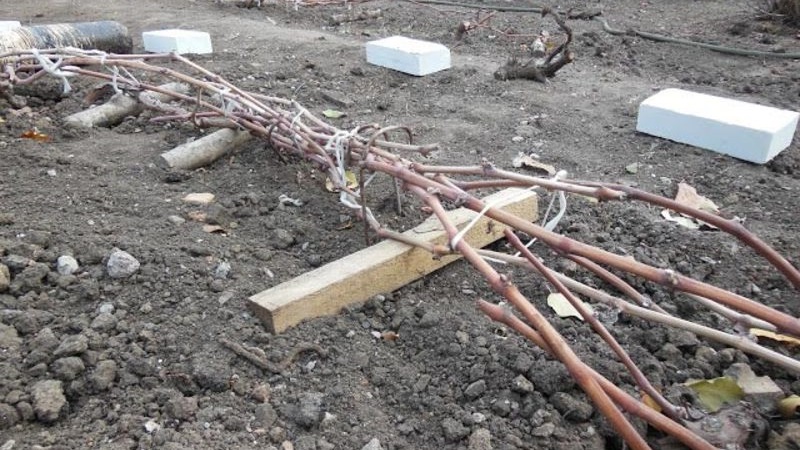
Which grapes do not harbor
Not all grape varieties require shelter... There are non-covering varieties that can withstand temperatures down to -35 ° C. Do not shelter grapes in regions with warm winters, where the temperature does not drop below + 5 ° C.
Non-covered ones are, as a rule, not canteens, but technical varieties... Even if the variety is frost-resistant, with a sudden thaw and new frosts, the bushes are covered with an ice crust, the buds in this state do not survive for more than two days and die. Non-covering frost-resistant varieties for the northern regions - Lydia and Isabella.
Preparing for shelter
Preparation for sheltering grapes for the winter is characterized by the following important stages.
Pruning
Carried out after leaf fall, in late September - early October, at above-zero temperatures.
In the process of trimming comply with the following rules:
- cut off all old, diseased and unripe shoots;
- leave 6-8 shoots of replacement from young branches, they should have 4 buds;
- two-year-old branches are pruned and up to 10-15 eyes are left as a reserve until spring pruning;
- do not cut the bushes of the current year;
- pruning is done with a disinfected, sharp pruning shears with cutting with garden pitch.
Watering
2-3 days before the shelter of the vine, the plant is watered for the resistance of the grape roots to frost... The moisture rate is calculated from the age of the plant, at the rate of 2 buckets for each year of life.
Top dressing
Carried out under the vine, within a radius of 1 m from it, usually 3 weeks before the onset of cold weather... Phosphorus-potassium fertilizers are used to ripen young branches and prepare roots for wintering.
Best Composition: 15 g of potassium salt and 30 g of superphosphate per 10 liters of water. Humus and wood ash, rotted compost are also used. Just 2 glasses of ash or up to 5 kg of humus is enough for 1 m² of vineyard.
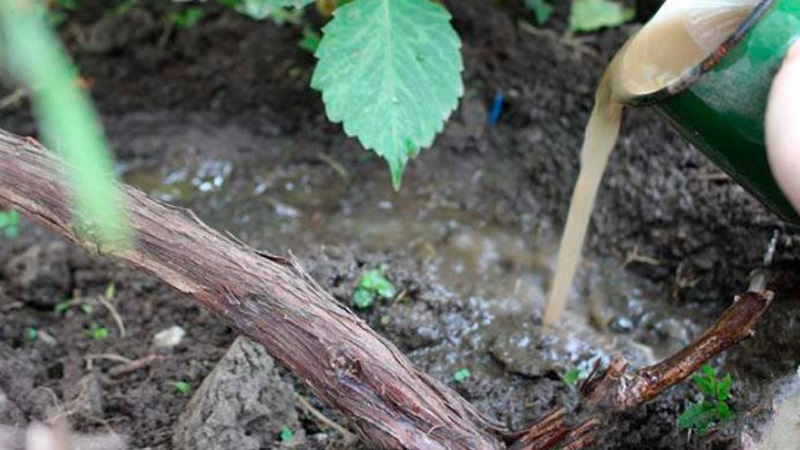
Treatment against pests and diseases
The procedure is carried out immediately after pruning the bushes.... The foliage and grass from under the vines are removed to protect against decay. The bush is treated with fungicidal preparations, such as a 3% solution of ferrous sulfate (spray the bush and the ground around the trunk), 1% solution of Bordeaux mixture, a solution of baking soda or lime.
In case of severe damage by pests, special preparations are used: "Nitrafen", "Topaz", "Ridomil".
Interesting on the site:
Features of warming grapes in the Moscow region
Disinfection of covering material
Shelter material is white, dry and disinfected... Special industrial fabrics are widely used: geotextile, lutrasil, spunbond.
Rodent-repelling herbs are placed between the layers of material and under the stem: tansy, wormwood, calendula, elderberry, wild rosemary. The branches and tops of the plant are laid out on the ground and treated with a pesticide or fungicide and dried.
Shelter methods
Different grape varieties and climatic conditions suit different shelter methods... For Ukraine and the southern regions, hilling and semi-shelter are suitable, in the Volga region and central Russia, sprinkling with earth is used, in Siberia and the Far East - simple bending.
The method of shelter is chosen based on the climatic conditions of their region. How to cover grapes - read on.
Stamp dripping
Used for winter-hardy varieties on young bushes... The vines of the first year are not pruned, but tied into a bunch, bent to the soil and covered with earth by 25 cm.
Semi-shelter
Suitable for temperate climates with low to medium frost resistance... The lower part of the bush is covered with earth, and the lashes adjacent to the ground are covered with straw, film or burlap. Good protection for the root system, but unexpected frost will easily kill unprotected buds.
Full cover
This method is suitable for regions with frequent temperature extremes and frost -20 ° С.
Vines are tied together and laid on the ground, covered with insulated material, wrapped on top with a film, stretching it so that there is no contact with the buds. Then they press the structure with an iron arc and sprinkle it with earth - reliable protection against frost is provided.
At times, the structure is opened slightly to avoid the greenhouse effect and the growth of fungal microorganisms.
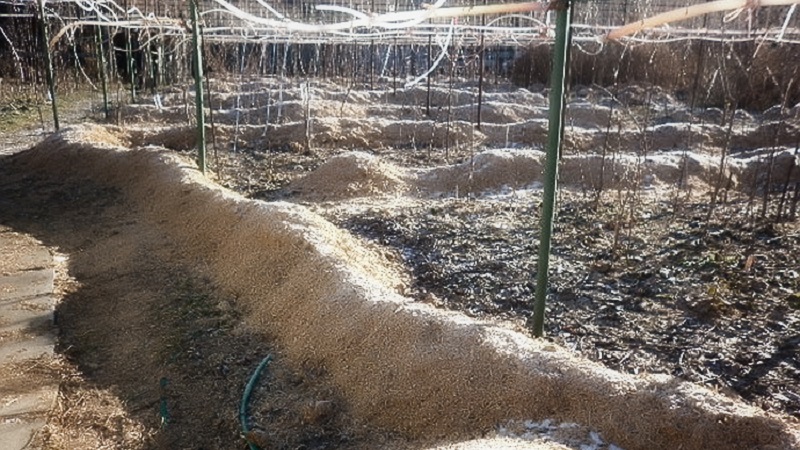
Thermal insulation materials with full cover:
- Snow, especially if the region has snowy winters. Snow is poured over the shelter or on the stems of the plant.
- Earth, with which the vine is covered by 20 cm. Cover until the topsoil freezes.
- Foliage... The vine is bent down, fixed with iron hooks. Pour foliage into large trash bags, tie and cover the plant. The method is used for a small number of bushes. In the spring, the bags are removed, arcs are placed and covered with non-woven material until the end of the frost.
- Straw or reed... Use similar to foliage. Straw is used as a mulching material for better heat retention.
- Other materials - sawdust, spruce branches, simple bags. Sawdust from above is covered with a film or linoleum from getting wet and freezing. In dry sawdust, mice often start, especially when the vines are not fully asleep. When sheltering with coniferous branches, bags of sugar or flour are placed on top and sprinkled with earth on 20 cm.
Dry shelter
The most reliable method against freezing in any region with a stable temperature regime, without kidney damping. A support is installed on which a double folded covering material is laid, on top - a plastic film with air vents along the edges.
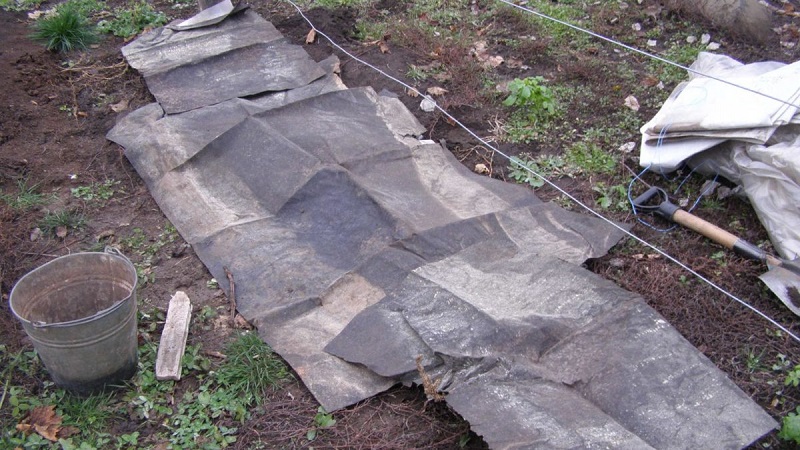
For dry shelter use:
- slate- laid on the ground, dry foliage is added on top, this is suitable for areas with little frost;
- plastic wrap- an inexpensive means of shelter, but after warming, a greenhouse effect often occurs with the awakening of kidneys, and after the onset of frost they die;
- arcscovered with agrofibre or other material and on top - with a light film with boards fixed at the edges;
- roofing felt suitable for shelter in regions with little snowy winters - the bushes are laid on the ground, covered with burlap or other insulation, roofing material is spread on top;
- cardboard boxes- such material quickly gets wet and deteriorates, therefore, in addition, the cardboard is covered with a film or other moisture-resistant material;
- plywood, linoleum, polypropylene bags.
Features of the shelter of young grapes
Annual grapes are not fed or pruned, but the tender young plant is covered more carefullywithout waiting for negative temperatures. From the end of August, watering is stopped and the tops of the shoots are cut off to coarse the wood.
If the bark does not turn brown by mid-autumn, the grapes are dug up and transplanted into dishes in a room with a temperature of + 10 ... + 15 ° C.
There are 4 ways to hide for young grapes:
- Hilling cuttings ground to a height of 30-40 cm, young buds remain closed.
- Semi-shelter... In this case, the lower part of the trunk is covered with straw, coniferous spruce branches or sawdust.
- Full cover... Cover the seedlings with 1.5 or 5-liter plastic bottles with an open neck and cover them with a 5-10 cm layer of earth.
- Shelter by car tires... Young vines are placed in a ring and placed inside the tire, sprinkling with earth around it. Another tire is placed on top, covered with insulation and fixed with bricks.
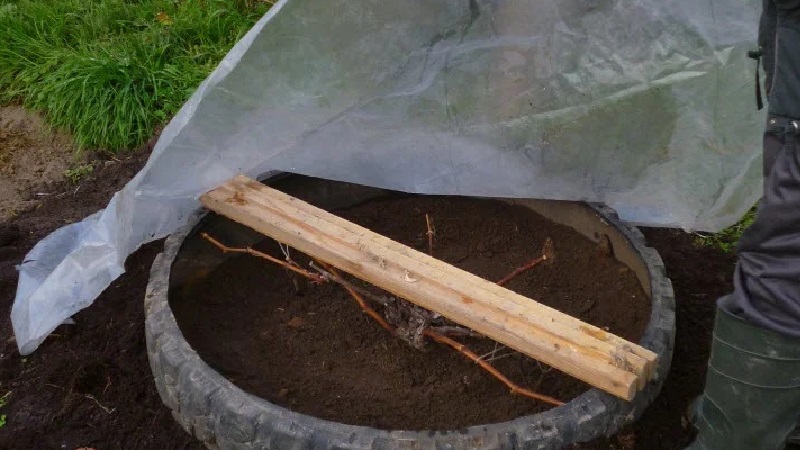
Common mistakes and how to avoid them
Major mistakes:
- non-observance of preparatory work before wintering - pruning, watering, feeding, treatment from pests and diseases;
- failure to comply with the terms of shelter - in case of a sharp cold snap, they urgently throw snow or earth into the root zone, wrap it up with waterproof insulation, cover with slate, roofing felt or boards;
- an incorrectly chosen method of shelter for the region - they take into account how much snow falls in winter, whether there are severe frosts, whether there are frequent thaws, how long does the snow melt in spring, whether there is stagnation of water;
- lack of ventilation - along the edges of the shelters, areas are left for ventilation or from time to time they are ventilated on their own;
- an excess of soil on young shoots over a film or other material leads to the death of a shrub - this is not allowed.
Conclusion
The methods of sheltering grapes depend on the climatic conditions in the regions. For the winter, grapes at an air temperature below + 15 ° C are insulated with one of the 4 main types of shelters. Subject to simple rules, the grapes will successfully overwinter and will delight the next season with a rich harvest.